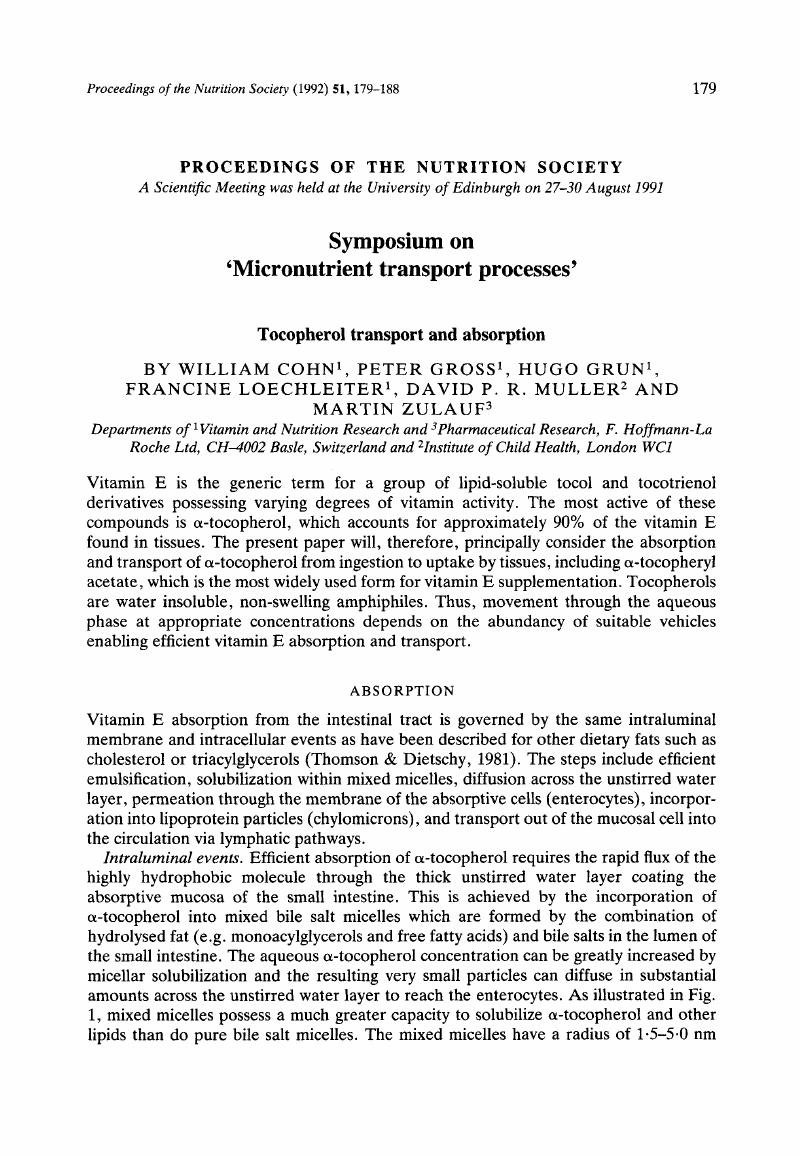Crossref Citations
This article has been cited by the following publications. This list is generated based on data provided by Crossref.
Saupe, J
Shearer, MJ
and
Kohlmeier, M
1993.
Phylloquinone transport and its influence on γ-carboxyglutamate residues of osteocalcin in patients on maintenance hemodialysis.
The American Journal of Clinical Nutrition,
Vol. 58,
Issue. 2,
p.
204.
Lie, Øyvind
Sandvin, Aslaug
and
Waagbø, Rune
1994.
Transport of alpha-tocopherol in Atlantic salmon (Salmo salar) during vitellogenesis.
Fish Physiology and Biochemistry,
Vol. 13,
Issue. 3,
p.
241.
Toutain, P.L.
Hidiroglou, M.
and
Charmley, E.
1995.
Pharmacokinetics and Tissue Uptake of D-α-Tocopherol in Sheep Following a Single Intraperitoneal Injection.
Journal of Dairy Science,
Vol. 78,
Issue. 7,
p.
1561.
Weiser, Harald.
Riss, Georges.
and
Kormann, Alfred W.
1996.
Biodiscrimination of the Eight α-Tocopherol Stereoisomers Results in Preferential Accumulation of the Four 2R Forms in Tissues and Plasma of Rats.
The Journal of Nutrition,
Vol. 126,
Issue. 10,
p.
2539.
Brink, Elizabeth J.
Haddeman, Edward
and
Tijburg, Lilian B. M.
1996.
Vitamin E incorporated into a very-low-fat meal is absorbed from the intestine of young rats.
British Journal of Nutrition,
Vol. 75,
Issue. 6,
p.
939.
Eastwood, Martin
1997.
Principles of Human Nutrition.
p.
177.
Blum, Juerg W.
Hadorn, Ulrich
Sallmann, Hans-Peter
and
Schuep, Willy
1997.
Delaying Colostrum Intake by One Day Impairs Plasma Lipid, Essential Fatty Acid, Carotene, Retinol and α-Tocopherol Status in Neonatal Calves , ,.
The Journal of Nutrition,
Vol. 127,
Issue. 10,
p.
2024.
Lanza, Elaine
Forman, Michele R.
Johnson, Elizabeth J.
Muesing, Richard A.
Graubard, Barry I.
and
Beecher, Gary R.
1998.
α-Tocopherol Concentrations in Plasma but not in Lipoproteins Fluctuate during the Menstrual Cycle in Healthy Premenopausal Women.
The Journal of Nutrition,
Vol. 128,
Issue. 7,
p.
1150.
Ball, G. F. M.
1998.
Bioavailability and Analysis of Vitamins in Foods.
p.
195.
Barbas, C.
and
Herrera, E.
1998.
Lipid composition and vitamin E content in human colostrum and mature milk.
Journal of Physiology and Biochemistry,
Vol. 54,
Issue. 3,
p.
167.
Swanson, J.E.
Ben, R.N.
Burton, G.W.
and
Parker, R.S.
1999.
Urinary excretion of 2,7,8-trimethyl-2-(β-carboxyethyl)-6-hydroxychroman is a major route of elimination of γ-tocopherol in humans.
Journal of Lipid Research,
Vol. 40,
Issue. 4,
p.
665.
Bosi, P
Cacciavillani, J.A
Casini, L
Lo Fiego, D.P
Marchetti, M
and
Mattuzzi, S
2000.
Effects of dietary high-oleic acid sunflower oil, copper and vitamin E levels on the fatty acid composition and the quality of dry cured Parma ham.
Meat Science,
Vol. 54,
Issue. 2,
p.
119.
Novelli Filho, Jose Luiz V. B.
Novelli, Ethel L. B.
Manzano, M. Anastacia
Lopes, Ana M.
Cataneo, Ana C.
Barbosa, Lais L.
and
Ribas, Bartolome O.
2000.
Effect of alpha-tocopherol on superoxide radical and toxicity of cadmium exposure.
International Journal of Environmental Health Research,
Vol. 10,
Issue. 2,
p.
125.
Nielsen, P.B.
Müllertz, A.
Norling, T.
and
Kristensen, H.G.
2001.
The effect of α-tocopherol on the in vitro solubilisation of lipophilic drugs.
International Journal of Pharmaceutics,
Vol. 222,
Issue. 2,
p.
217.
Rimbach, Gerald
Minihane, Anne Marie
Majewicz, Jonathan
Fischer, Alexandra
Pallauf, Josef
Virgli, Fabio
and
Weinberg, Peter D.
2002.
Regulation of cell signalling by vitamin E.
Proceedings of the Nutrition Society,
Vol. 61,
Issue. 4,
p.
415.
Allen, P.C.
and
Fetterer, R.H.
2002.
Interaction of Dietary Vitamin E with Eimeria maxima Infections in Chickens.
Poultry Science,
Vol. 81,
Issue. 1,
p.
41.
Jeanes, Yvonne M.
Hall, Wendy L.
Ellard, Susan
Lee, Elizabeth
and
Lodge, John K.
2004.
The absorption of vitamin E is influenced by the amount of fat in a meal and the food matrix.
British Journal of Nutrition,
Vol. 92,
Issue. 4,
p.
575.
Huang, Han-Yao
Berndt, Sonja
and
Helzlsouer, Kathy J.
2004.
Cancer Chemoprevention.
p.
451.
Fleming, Craig
Maldjian, André
Da Costa, Daniel
Rullay, Attvinder K
Haddleton, David M
St John, Justin
Penny, Paul
Noble, Raymond C
Cameron, Neil R
and
Davis, Benjamin G
2005.
A carbohydrate-antioxidant hybrid polymer reduces oxidative damage in spermatozoa and enhances fertility.
Nature Chemical Biology,
Vol. 1,
Issue. 5,
p.
270.
Scislowski, Valérie
Bauchart, Dominique
Gruffat, Dominique
Laplaud, Paul‐Michel
and
Durand, Denys
2005.
Effect of dietary n−6 and n−3 polyunsaturated fatty acids on peroxidizability of lipoproteins in steers.
Lipids,
Vol. 40,
Issue. 12,
p.
1245.



